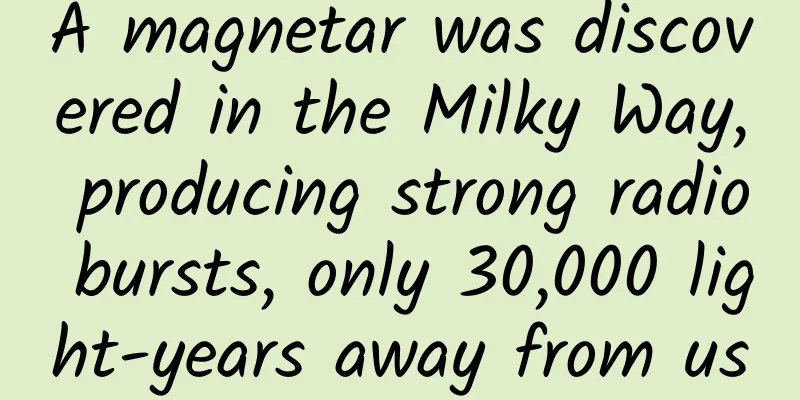A magnetar was discovered in the Milky Way, producing strong radio bursts, only 30,000 light-years away from us

|
[Mobile software: Bo Ke Yuan] Using the Canadian Hydrogen Intensity Mapping Experiment (CHINE) radio telescope, astronomers have detected a bright, millisecond-duration radio burst from a Milky Way magnetar named SGR1935+2154. This is the discovery of an extremely strong astronomical event, which is important for improving the understanding of the origin of fast radio bursts (FRBs). Magnetars are neutron stars with extremely strong magnetic fields, more than one quadrillion times stronger than the Earth's magnetic field. The decay of the magnetic field in magnetars powers the emission of high-energy electromagnetic radiation, for example, in the form of X-rays or radio waves. Fast radio bursts are intense bursts of radio emission lasting a few milliseconds, showing the characteristic dispersion sweeps of radio pulsars. The physical nature of these bursts is still unclear, and astronomers have investigated various explanations, including synchronous maser radiation from young magnetars in supernova remnants, and the tips of cosmic strings. SGR1935+2154 is a galactic magnetar located about 30,000 light-years away in the constellation Vulecula that exhibits transient radio pulsations. Now, it has entered a period of unusually intense X-ray burst activity. A team of astronomers led by Paul Scholz of the University of Toronto in Canada observed the pulsar and detected a two-component bright millisecond radio burst, similar to the fast radio bursts observed at extragalactic distances. The bursts were detected simultaneously in 93 of the 1,024 CHAME/fast radio burst beams, indicating that this was an extremely bright event. The detected event consisted of two sub-bursts lasting 0.585 milliseconds and 0.355 milliseconds, with the second sub-burst occurring approximately 0.03 seconds after the first. The dispersion of the two burst components was found to be about 332.72 pC/cm~3. The fluences of the two subbursts were 480 and 220 kJy milliseconds, respectively. The researchers point out that such values, together with the estimated distance to SGR1935+2154, indicate a burst energy of 400-800 MHz at the level of 30 erg, which is brighter than the energy of any radio-emitting magnetar known to date. The new radio burst was discovered when SGR1935+2154 was in a prolonged active period, during which hundreds of high-energy bursts were reported. The researchers note that the burst described in the study is the most radio-bright event of its kind ever detected from a Milky Way magnetar. The astronomers considered the possibility that the newly detected burst could be a fast radio burst. First, the morphology of the radio burst is similar to that of a fast radio burst, and in particular, the duration of its subcomponent is typical of the burst widths of the 18 repeating fast radio burst sources discovered by CHINE. In addition, this burst was found to be only one to two orders of magnitude lower than the observed burst energy of a typical fast radio burst. But if they are located at a closer distance, the energy may be similar to some identified fast radio bursts. Whether the newly discovered radio burst from SGR1935+2154 is a fast radio burst remains an open question, but the researchers say its detection may help fill the energy gap between the brightest galactic sources and extragalactic fast radio bursts. Therefore, this event bridges a large part of the radio energy gap between the Milky Way's magnetar population and fast radio bursts, strongly supporting the view that magnetars are the origin of at least some fast radio bursts. Science X Network | Copyright Science X Network/Tomasz Nowakowski/Phys Research published in the journal arXiv BoKeYuan|Science, technology, research, popular science Follow [Bokeyuan] to see more beautiful cosmic science |
>>: Your parents’ health is not as healthy as you think!
Recommend
The storm of radio and television rectification is coming. The current situation of the Internet TV market
Since June this year, the State Administration of...
What! We won't be able to drink Coke in half a year?
On a hot summer day, opening a bottle of ice-cold...
The five unspoken rules in the entrepreneurial circle. Understand these before starting a business!
[[153592]] What are unspoken rules? Wu Si said in...
Scientists study new technology to activate human eyes: able to see infrared light
Any science textbook will probably say that human...
iOS 9's new features will target Google's search business
There have been a lot of reports about Apple addi...
Assessing the habitability of the Red Planet: Isotopic mysteries in the Martian atmosphere
Mars, also known as the "Red Planet", h...
Douyin’s violent way of making money, quickly and accurately obtaining popular materials, and infinitely copying accurate traffic - Xiaobai gains 10,000 fans a day!
Short video money-making course, revealing the vi...
Down jacket warning map: More than three quarters of the country needs to wear down jackets
The cold wave is coming again! Currently, the fif...
Async/Await in Swift — Detailed Code Examples
Introduction async-await is part of the structure...
After 3 years of iOS development, he only needed 5 minutes to convince the interviewer
Preface The one who borrows the carriage and hors...
What are the functions of Foshan lawyer mini program development and how much does it cost to develop a lawyer legal consultation mini program?
Recently a friend consulted me and wanted to make...
Taiyuan quickly ranks and dominates the screen, and a detailed explanation of the B2B website ranking and dominance operation case!
Using independent websites for keyword ranking (S...
How to combine new product marketing strategies with big data?
The strength of a country's economic soft pow...
Apple and Google's health code exposes the "digital divide": 2 billion old phones cannot be used
Beijing time, April 20, market research firm Coun...
B station's complete set of promotion and traffic generation methods
Bilibili, abbreviated as B station, is a small br...









